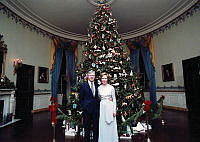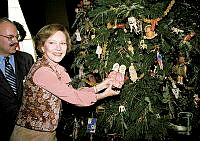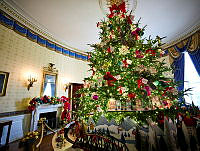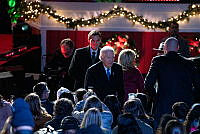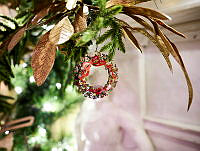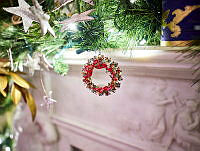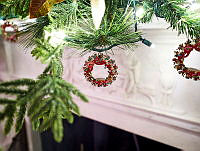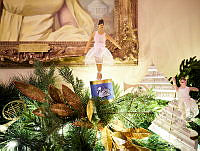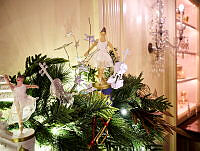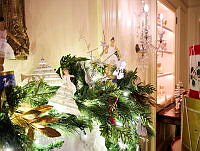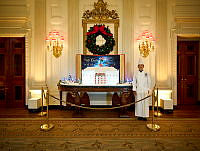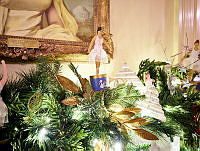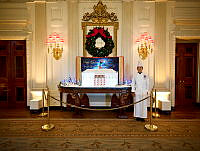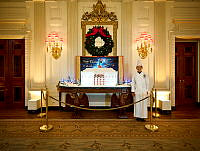Nell Arthur's Memorial Window
History Reflected in St. John's Church
Copyright © December 01, 2014 White House Historical Association. All rights reserved under international copyright conventions. No part of this article may be reproduced or utilized in any form or by any means, electronic or mechanical, including photocopying, recording, or by any information storage and retrieval system, without permission in writing from the publisher. Requests for reprint permissions should be addressed to books@whha.org
Stained glass, a medieval art, was revisited in the historically retrospective nineteenth century. The art was a prominent feature of two significant renovation projects in Washington, D.C., during the presidency of Chester Alan Arthur (1881–85). Saint John’s Church in Lafayette Square engaged Lorin, a studio based in Chartres, France, to create stained glass windows for its new pictorial glazing program. Across the street, on the south side of Lafayette Park, the president entrusted the decoration of the White House public spaces to a rising American designer, Louis Comfort Tiffany. The pièce de résistance of that commission was an opalescent glass screen separating the Entrance Hall from the Cross Hall. In their contrasting artistry and technical execution, the two glass installations tell the story of late Victorian glass in America, the evolution of taste, and the development of an American style.
Medieval stained glass, the technique of assembling small colored pieces of glass within a metal framework, reached an artistic apex in the thirteenth and fourteenth centuries. A new style of building made possible by the development of complex vaulting and buttressing systems featured pointed arches, soaring ceilings, and enlarged window openings in the walls. Light became a transformative element in the interior space, and the task of glazing its entry points called for architectural ingenuity, alchemical mastery, and decorative flair. Northern European cathedrals, such as those in Chartres in France, York Minster in England, and Cologne in Germany, are renowned examples of achievements in Gothic architecture and stained glass.

The stained glass window at Saint John’s Church depicting the Resurrection was created as a memorial to Ellen Herndon Arthur. At the request of her husband, President Chester A. Arthur, the window was placed at the south transept of the church so that he could see it at night from the White House.
Bruce M. White for The White House Historical AssociationThe Protestant Reformation that began in 1517, with its abhorrence of imagery and extravagant adornment of churches, initiated a gradual decline of stained glass over the next two centuries. The Baroque style, which was adopted by the ensuing Counter-Reformation movement in the Catholic Church, was best expressed in the chiaroscuro of painting and rippling masses of sculpture. By the seventeenth century, technological advances in glassmaking also made it possible to produce bigger and more visually uniform panes for windows. The mosaic-like assembly of medieval glazing fell out of favor as window glass became another canvas to showcase the artist’s skills with paint and brush.
The seed of antiquarian interests in the eighteenth century flowered into the many historic revivals of the nineteenth. The Gothic Revival began as a romantic look at the medieval past as a time of virtue, partially in reaction to the perceived societal ills caused by industrialization. The Renaissance Revival reasserted the classical symmetry and proportions of Roman temples as the guiding principles of order and logic, while the Rococo Revival rekindled an appreciation for the playfulness and freedom of curvilinear forms and seashell motifs. Nineteenth-century historicism sought to reinterpret, rather than reproduce, the past. Thus elements from different styles were often combined to form a “Revival pastiche” so characteristic of the Victorian era. While inspired by historical examples, the stained glass in Saint John’s Church and the opalescent screen in the White House were reflections of their own time.

President Chester Arthur's wife, Ellen (Nell).
Library of CongressFrench Glass for “The Church of the Presidents”
Benjamin Henry Latrobe, the architect of the U.S. Capitol, designed Saint John’s Church. From the onset, it had a fashionable and affluent congregation. The tony Lafayette Square neighborhood just north of the White House was home to the wealthiest and most prominent individuals in Washington. Since it opened for services in 1816, every American president either became a member of Saint John’s or visited at least once.1 President Abraham Lincoln broke with tradition by choosing the New York Presbyterian Church as his church during his presidency, but he was known to walk across the street from the White House and sit quietly in one of Saint John’s back pews during service. When President Arthur began regularly attending services there, he revived Saint John’s old reputation as “The Church of the Presidents.”2
In 1883, Saint John’s vestry approved a building expansion plan to accommodate the growing membership. The design by James Renwick included the installation of stained glass in the windows, which had until then been fitted with clear panes. Appointed to the stained glass committee were J. C. Bancroft Davis, a judge on the U.S. Court of Claims; Reverend William Leonard, the new rector; John Alsop King; and E. F. Andrews. Correspondence between Judge Davis and Dr. Leonard reveal that they were the key players in the endeavor, working closely with the architect, the glass artists, and craftsmen. James Renwick, who had achieved early prominence for his design of the Smithsonian Castle, had just concluded work on Saint Patrick’s Cathedral in New York City, his biggest and most famous project to date. In a letter dated June 26, 1883, to Judge Davis, he recommended Lorin, a French stained glass studio he had employed for several windows in Saint Patrick’s and Grace Church in Manhattan: “The glass stainer I think best is Lorin of Chartres, for fine figure work about 11 to 15 dollars per square foot will do I think. This is about the cost of the new memorial windows at Grace Church.”3
Two days later Renwick followed up with more information about the process. He also sought to assure Judge Davis that although Nicolas Lorin, the founder of the studio, had just died, the quality of the windows remained high:
"The glass stainer always furnishes designs free of harge. When the member of the vestry visits Chartres he must state what kind of glass he wants for each window and the price you want to pay as glass may have gone up in price since the Cathedral was done but I think you will have no difficulty in getting it done for the price I have named. . . . I enclose a note to Madame Lorin who is now head of the work, M Lorin being dead but the same men who did the work for the Cathedral are still with her and their work is as good as ever."

On June 9, 1883, James Renwick wrote to Judge J.C. Bancroft Davis advising on the design of the stained glass window: “I have made several sketches for window over the Chancel, and send you tracing of the one which seemed most fitting . . .”
Library of CongressIn a postscript, Renwick offered Tidden & Arnold, an American maker, as an option and also as a point of price comparison. His tone suggested that before taxes and delivery charges, Lorin’s fees would be very competitive:
"Messrs Tidden & Arnold of Brooklyn were here and say that they will furnish designs for and make all windows with figures of opalescent glass for twelve dollars per foot in the church and 5 dollars for fine Mosaic work of opalescent and cathedral glass also. . . . I write this in order that you may consider it before making an offer to Lorin. . . . The price offered by Tidden & Arnold will reduce the cost . . . and you should not offer any more to Lorin, of course first deducting the duty & charges of transport."4
The committee agreed upon a stained glass program illustrating scenes from the life of Jesus, the Gospel of Saint John, or the Apocalypse. The campaign to sign up sponsors for each window was under way in the summer of 1883, when Judge Davis traveled to Chartres, France, to meet with Madame Lorin. From 1883 to 1885, the windows were designed, the glass made and cut in France, and then it was shipped for assembly by N. H. Egleston Jr., a New York glass studio commissioned by Renwick for some of the minor windows at Saint John’s.5
One of the Lorin windows at Saint John’s was a memorial window to Ellen “Nell” Herndon Arthur, the late wife of the president. Born in Fredericksburg, Virginia, and raised in Washington, D.C., she and her family were members of Saint John’s, and Nell Arthur, known for her beautiful voice, sang in the church choir. In 1859 she married Chester Arthur, then a rising young civil rights lawyer, at the elegant Calvary Protestant Episcopal Church in New York City, an early Renwick design. The ceremony was officiated by the Reverend Dr. Smith Pyne, rector of Saint John’s Church at the time.6 Tragedy struck the family in 1880, when, at the age of 42, Nell Arthur caught pneumonia after being out on a chilly January night. She died, leaving two children, Chester Alan II, age 15, and Ellen, eight. Chester Arthur succeeded to the presidency less than a year later, after President James Garfield died from a gunshot wound dealt by an assassin.

James Renwick's letter to Judge J.C. Bancroft Davis continued by saying: “The glass stainer I think best is Lorin of Chartres, for fine figure work about 11 to 15 dollars per square foot will do I think. This is about the cost of the new memorial windows at Grace Church.”
Library of CongressIn July 1883, Reverend Leonard called at the White House to ask President Arthur to be a patron for a memorial window dedicated to his late wife. He met with Fred J. Phillips, the president’s secretary, who conveyed Arthur’s request for the south transept window. The location made sense, for he had chosen a bedroom on the North Front for his own private chambers on the Second Floor of the White House,7 and he would be able to see the window from there. The president also asked Saint John’s to submit a list of subjects from which he could choose.8
By September, an appointment had been set for Judge Davis to meet with the president about the window designs. A letter from the Executive Mansion signed by Phillips and dated September 14, 1883, confirmed that the president had made a selection: “Enclosed I sent you the design as requested. The President will retain his for the present.”9
The Ellen Herndon Arthur memorial window is composed of two panels, each depicting a scene with an empty tomb, a traditional symbol of the Resurrection. The upper panel illustrates Mark’s account (Mark 16:1–6) of three women going to the burial site at dawn and being greeted by young man dressed in white, proclaiming the risen Christ. The lower half depicts the empty tomb from the gospel of John (John 20:11–12), which describes the encounter between Mary Magdalene and two white-clad angels just before she sees the resurrected Messiah. She is recognizable by her flowing red hair and the nearby jar. The latter is her traditional attribute from medieval Christian iconography, based on a tenuous association with the nameless woman who anoints Jesus’s feet with perfume from an alabaster vessel (Luke 7:36–50).
The design of the top panel is clearly derived from a work attributed to Julius Schnorr von Carolsfeld, a German religious painter best known for publishing Die Bibel in Bildern, a collection of woodcuts depicting biblical scenes, in 1860. The work was widely circulated and very influential in the design of nineteenth-century stained glass. By that time, it was fairly common practice to use painting as a design source for stained glass. The Renaissance, however, had introduced foreshortening and single point perspective to visual art, and the Victorians, while enamored of the past, did not believe it meant embracing the schematic drawing of the medieval period, which they perceived to be flawed.10 Thus classically modeled and proportioned figures were often portrayed in stained glass within Gothic pointed arches. The Ellen Arthur Memorial window, along with the others by Lorin in Saint John’s Church, exemplified the nineteenth-century fondness for amalgamating historical styles in highly decorative compositions.

Commissioned by President Chester A. Arthur from Louis Comfort Tiffany, the glass screen is depicted here in a contemporary painting by artist Peter Waddell. Waddell’s scene focuses on the introduction of electricity in 1891.
Peter Waddell for the White House Historical AssociationLouis Comfort Tiffany Comes to the White House
In 1882, a year before James Renwick recommended Lorin for the stained glass commission at “The Church of the Presidents,” Chester Arthur selected a designer who would create a different kind of artistic glass for the President’s House. He employed Louis Comfort Tiffany and his partners in the Associated Artists design firm to decorate most of the State Rooms and Entrance Hall on the First Floor. At 34, Tiffany was becoming well known; he had just finished renovating the widely praised Veterans Room at the Seventh Regiment Armory on Park Avenue in New York City. He was the son of Charles Lewis Tiffany, a noted jeweler and good friend of the president. Chester Arthur and the elder Tiffany were both members of the elite Union League Club of New York, which was another brilliant showcase for the young Tiffany’s work.11
Associated Artists was composed of Louis Comfort Tiffany, the textile designer Candace Wheeler, the furniture specialist Lockwood de Forest, and the painter Samuel Colman. During their brief collaboration (1881–83), they created memorable interiors in their version of the Aesthetic movement style, which featured heavy Japanese, Moorish, and East Indian influences. Descriptions of Tiffany’s stained glass from this period provide insight into the exotic design perspective he brought to the White House project. The New York Times published a glowing review of the Veterans Room at the Armory: “As for the stained windows . . . which pierce this wall, a glazier might describe them as Oriental in treatment; angular, with olive ground, on which are distributed crescents of opals or jewels.”12
The Armory interior is extant and thus provides an example of the type of glass Tiffany was using in the early 1880s. During this period, he was experimenting with different glass formulas at Heidt Glass Works in Brooklyn; it would most likely have been the provider of his window glass for both the Armory room and the White House screen.13 The latter was removed in 1902 and is documented only in black-and-white photographs. From those images one can discern a composition of light and dark, irregularly shaped ovals, oblongs, and elongated rosettes. We are left to imagine the colors from contemporaneous accounts: “A new era—the era of stained glass, tiled fireplaces and high mantelpieces—has dawned upon the White House. Estheticism reigns within its walls supreme. Peacock blue and silver, crimson brown and dead gold, delicate primrose and pale fawn—these are now the prevailing tints of the interior furnishings.”14

Louis Comfort Tiffany (seen here c. 1908).
Library of CongressHarper’s Weekly, in January 6, 1883, described the glass screen in detail:
"Perhaps the most striking and original of the decorations is the screen which fills the arcade between the corridor and the vestibule. This is now a glass mosaic of varying but symmetrical patterns, composed of sheets of opalescent glass incrusted [sic] with vitreous jewels of topaz and ruby and amethyst . . . the centre of the central arch is occupied with a great oval composition of mosaic of yet more vivid and luminous colors. There is a quaint suggestion of symbolism in the four eagles which surround this and the rough monogram “U.S.” which appears here and there in opalescent glass; but these are quite incidental, and the motive of the work is purely decorative, and aims at harmonious and sparkling arrangement of rich color."15
Tiffany’s early window designs employed geometry and stylized plants and animals, in contrast to the realistically drawn figures and scrolled leafy borders at Saint John’s. And while Lorin used traditional colored, translucent glass, Tiffany developed a new kind of substance by exploring various techniques at Heidt.16 He wanted to create glass that had painterly effects—color gradations, streaks, ripples, and other irregularities that were normally achieved with the application of enamels. He found that the addition of metal oxides to the molten batch produced an endless variety of glass that could be used to suggest clouds, plants, textiles, and other surfaces. The resulting material was thicker and opalescent rather than translucent. It filtered less sunlight from outside, but reflected indoor illumination. Whereas traditional stained glass would be dark at night, the right kind of opalescent glass could give off a glow from a gas or electric lamp. It became a distinct American innovation in the art of stained glass. By the end of the nineteenth century, opalescent leaded windows were a decorative staple of churches, homes, and public spaces all over the country. Tiffany’s later windows featured landscapes and explicitly detailed figures as he refined his glass formulas and assembly techniques.
A little more than two decades after the White House screen, Tiffany designed a Resurrection window for Saint Paul’s Episcopal Church in Norfolk, Virginia. For the subject, he chose the three women at the empty tomb of Christ, as Lorin had for the upper panel of the Resurrection window in memory of Nell Arthur at Saint John’s Church. The design similarly borrows from nineteenth-century painting sources, and in this instance, Tiffany looked to the work of Bernard Plockhorst (German, 1825–1907) and William-Adolphe Bouguereau (French, 1825–1905). Trained early on as a painter, he was now using opalescent glass as a painterly medium.

Commissioned by President Chester A. Arthur from Louis Comfort Tiffany, the glass screen, depicted in a 1902 photograph, stood in the White House Entrance Hall from 1883 until 1902.
Library of CongressDe Gustibus Non Est Disputandum
The two innovations that occurred almost concurrently in the White House and its neighboring church offer a view into the plurality of decorative idioms at the end of the nineteenth century and the Victorian fondness for assembling them into a collective whole. “There is no arguing about taste.”
Saint John’s Church, guided by the reputation and expertise of James Renwick, opted for windows made by a studio in Chartres, a French town whose name was synonymous with Gothic architecture and stained glass. That Lorin was founded in the nineteenth century and could not claim any direct association with the renowned windows of Notre Dame de Chartres was not a matter of concern. Lorin, by virtue of its location, was perceived to be steeped in the tradition of the medieval art. In a letter to his friend Judge Davis, just before the trip to Chartres, the former secretary of state and Saint John’s congregant Hamilton Fish teased him about the French windows, “Would Latrobe recognize it as having originated in his conception?”17 Nevertheless, it was a fashionable choice for a fashionable church.
President Chester Arthur was a man of definite aesthetic preferences who took a fairly active hand in the redecoration of the White House.18 His choice of an American designer could be read today as a nationalistic act, but it was more likely a reflection of his sophisticated New York tastes. Tiffany and the Associated Artists were a very au courant choice, not surprising from a president who moved in artistic and stylish circles.

The Arthur memorial window is seen from across the sanctuary, beyond the presidential pew, inside Saint John’s Church, in 2009.
Bruce M. White for The White House Historical AssociationThe art of opalescent stained glass grew into a signature American style by the end of the nineteenth century. Its popularity peaked and then waned with post–World War I modernism. Louis Comfort Tiffany died in 1933, by which time opalescent windows were considered out of fashion. In a sense, the White House was on the leading edge of change with the 1902 renovation during the presidency of Theodore Roosevelt. The prestigious firm of McKim, Mead & White, masters of Beaux-Arts Neoclassicism, was hired for the massive job of preserving the historic exterior look and basic layout of the White House while reconfiguring the interior to meet the modern demands of work and domestic life. In their architects’ report to the president, they listed among their problems and proposed solutions “to remove such excrescences as had been allowed to accumulate about the White House to the detriment of its fine architectural features and its dignity as the home of the President of the United States.”19 This was a reference to the interior furnishings and decor that were now considered passé and offensively Victorian. The once celebrated Tiffany glass screen was one of the first “excrescences” to go.
On January 21, 1903, the screen was auctioned off as unwanted property and purchased by Turner A. Wickersham, a real estate agent for a Chesapeake Bay resort development. It is believed to have been installed at the Belvedere Hotel in Chesapeake Beach, Maryland, and destroyed when the building burned to the ground in 1923.20 Fortunately, Saint John’s Church has been a responsible custodian of its historic legacy, actively conserving its architecture and interior furnishings.21 Visitors to the church today continue to enjoy and appreciate the Lorin stained glass.
Only black-and-white images of the Tiffany screen remain. Perhaps because no color images have survived, and because the documentation of its existence after the White House is scant, it has continued to capture the imagination of historians, glass scholars, and curious tourists. First hailed as an artistic masterpiece, then discarded as Victorian embarrassment, it has become a romantic image, an elusive memory, and an alluring mystery. It is perhaps appropriate that the White House of Chester Alan Arthur, elegant bon vivant, who came to the presidency through tragic circumstances, is distinguished by the work of the most famous American decorator. The opalescent Tiffany screen, though lost, continues to lend luster to history.

Pedestrians on Sixteenth Street pass Saint John’s Church in a photograph taken in the 1890s. The Nell Arthur memorial window is centered on the south transept facing H Street and Lafayette Park.
Library of Congress





















